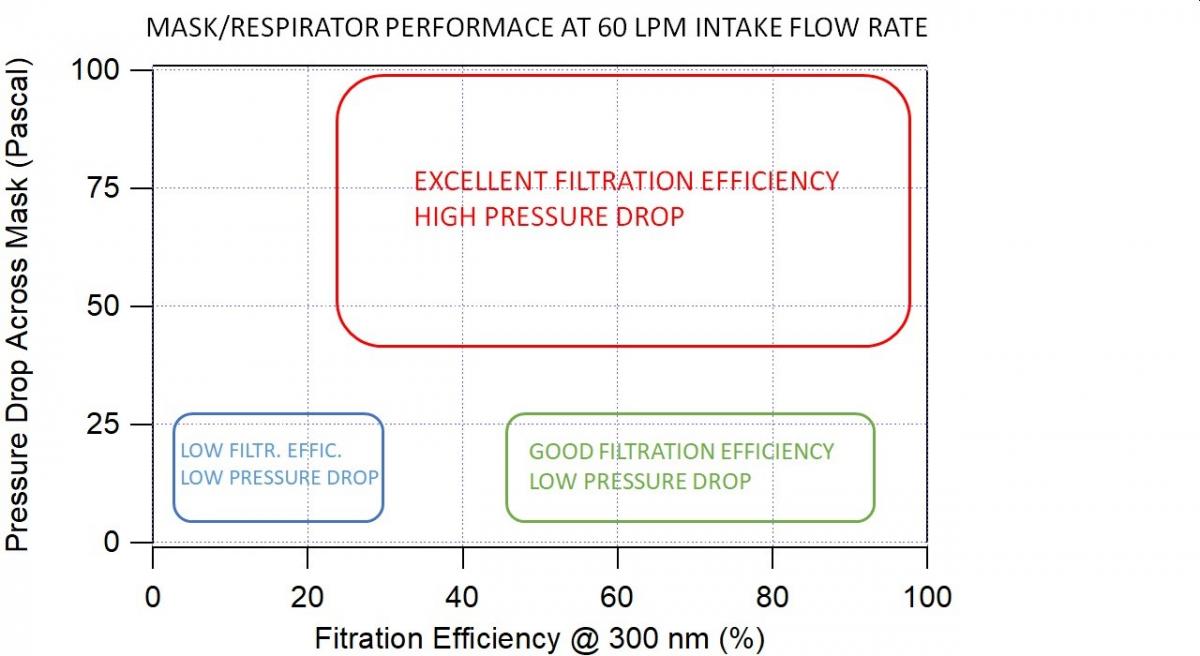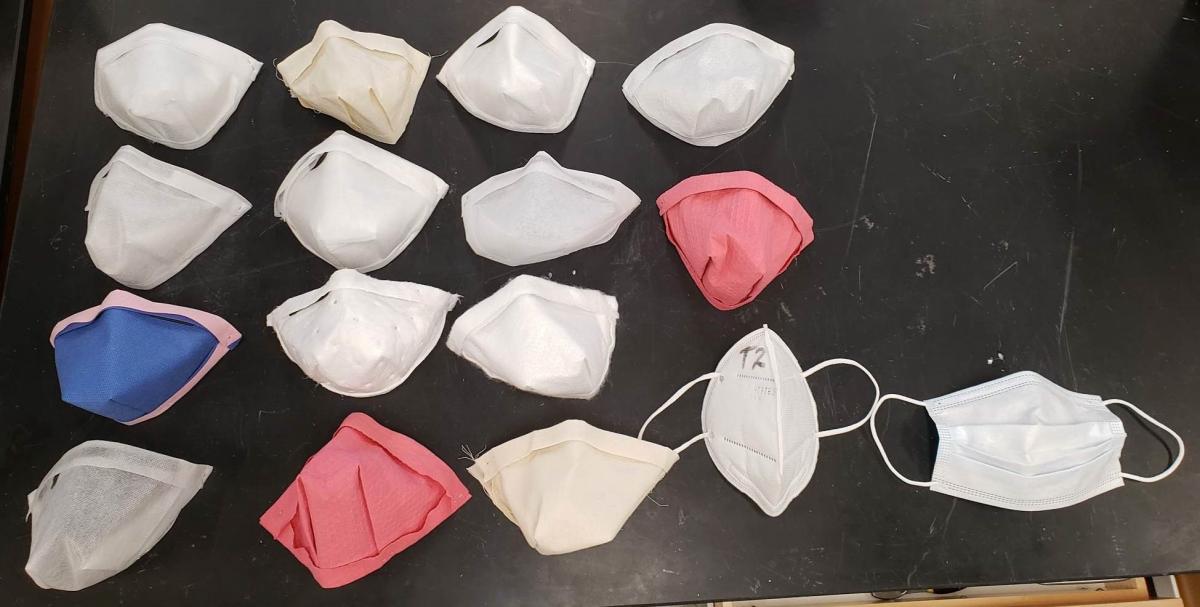Focus on the Lab
Jim Smith and his mask research
 Along with everyone else, the COVID-19 pandemic has brought massive changes to the lives of AirUCI researchers. For many of us, those changes have extended into the lab. Since March, Professor Jim Smith’s Ultrafine Aerosol Research Group has been focusing its efforts on mitigating the airborne transmission of the coronavirus through testing, designing, and educating the public about better face masks.
Along with everyone else, the COVID-19 pandemic has brought massive changes to the lives of AirUCI researchers. For many of us, those changes have extended into the lab. Since March, Professor Jim Smith’s Ultrafine Aerosol Research Group has been focusing its efforts on mitigating the airborne transmission of the coronavirus through testing, designing, and educating the public about better face masks.
In an excellent example of collaboration in AirUCI, Jim has formed the UCI Mask team, a multidisciplinary group that includes AirUCI’s Dr. Mike Kleinman (an expert in environmental toxicology) and Dr. Terry Sanger, UCI engineering professor and chief science officer of Children's’ Hospital of Orange County. Terry’s postdoc, Dr. Jonathan Realmuto, provides key expertise in mask construction as an expert in wearable robotics.
Over the past four months, the UCI Mask team developed a mask design that makes use of a folding procedure (origami) to transform a filtration base material into a mask. The design can provide a range of filtration efficiencies based on material choice, can be easily scaled to accommodate different facial sizes, and can be fabricated by non-experts.
The Origami Mask has several advantages over most cloth masks:
- It can be made out of any 9”x9” piece of material. This has huge advantages in that people can select the material according to the application. For running or walking outside, one would choose a highly breathable material. If entering a crowded place, a material that has better filtering capabilities is a more appropriate choice.
- It’s easy and cheap to make. All that is needed is the material, a stapler, some wire bands from coffee bags, and an elastic strap or shoestring. No sewing skills are required and there are only a few folds that need to be made.
- The design keeps the filter media off the face, which makes it easier to speak without sounding muffled.
- The design seals better than just about any other design that the group has tested. This means no fogging of glasses, but more importantly it means that the filtration abilities are controlled by the filter media and not by leakage (as anyone who wears glasses can attest, many masks leak).
Their mask research thus far has focused on masks as respiratory protection. The masks they develop and study not only protect others from potential virus-containing droplets that are emitted when we talk, cough, or sneeze, but also protect us from those emitted by others. It’s important to make this distinction because exhaled droplets are often larger than particles and droplets that we inhale. When other researchers study masks’ performance for smaller, inhaled droplets and particles they are really looking at the worst-case scenario for mask performance.
This is critically important for health care workers and essential workers, of course, and a key reason why Jim’s mask group conducts this research. However, for the rest of us who are not exposed to potential virus-containing aerosol particles on a day-to-day basis, most any mask will effectively remove larger exhaled droplets and provide the effective controls needed to reduce the spread of viruses.
A face mask has two very important properties that can be measured:
- Effectiveness as a filter: Filters don't have the same filtration efficiency for all particle sizes, so his group often lists mask performance for particles that are 300 nm in diameter because this is considered the "most penetrating particle size," or MPPS.
- Ease of breathing through the mask: Jim’s team measures this as the pressure drop, the difference between the outside and inside of the mask when air is drawn through it at a rate that is similar to a normal breath. The lower this pressure drop, the easier it is to breathe.
For every mask that is tested in the group, they measure the filtration efficiency and the pressure drop using a test mannequin. All masks leak a little where the mask meets the face, and the group can determine how much a mask leaks by first measuring these properties for a mask that is fit directly on the mannequin head, then measuring again with the mask sealed to the mannequin head using duct tape. If the mask leaks, the sealed mask would have a higher efficiency and a larger pressure drop compared to the unsealed mask. (See how they do this!)
An additional point is that often the filtration efficiency and pressure drop of a mask are inter-related: a mask that is a good filter will have a higher pressure drop and is therefore difficult to breathe through. This can be seen by making a plot of the pressure drop versus the filtration efficiency at the MPPS for each mask they tested (see the chart below). When they plotted the data for a variety of commonly used masks and for the Origami Mask with different filter materials, the group found that face masks fall into three categories and, inspired by the story of Goldilocks and the three bears, one of these is too much, one is too little, and one is just right.
The red category of masks is located in the upper right corner of the plot, meaning that they exhibit high filtration efficiencies and large pressure drops. Included in this category are N95 and KN95 respirators as well as surgical masks. Medical professionals know how to properly fit these masks to their faces so theirs will perform at the upper right corner of this region in the graph below. Unfortunately for the rest of us, too often these masks do not fit properly.

For instance, many KN95 masks use ear loops that are incapable of providing the tight seal that is required to eliminate leaks. This is why the actual size of the red region in the plot is so large: while a medical professional can have >95% efficiency with a 100 Pa pressure drop that makes it difficult to breathe, many of us who don these masks experience efficiencies as low as 25% because of leaks that bring the pressure drop to about 40 Pa (well, at least it’s easier to breathe!).
Masks in the red category are saving the lives of health care workers and first responders around the world, but for the rest of us it’s just TOO MUCH… too high a pressure drop that makes leaks too likely and leads to lower overall performance for the non-professional.
The blue category of masks is shown in the lower left corner of the plot, indicating that they have the lowest filtration efficiencies and lowest pressure drops. This category includes the fabric masks that most people have been wearing for the past several months. Masks such as these are excellent at removing large exhaled droplets that are associated with talking, coughing, and sneezing, but as respiratory protection these masks are TOO LITTLE… filtration efficiencies for small particles that are too small, albeit with pressure drops that makes these masks comfortable to wear.
Like the story of Goldilocks and the three bears, there is a third option that’s JUST RIGHT. This is a category of masks shown in green in the plot and characterized by high filtration efficiencies but low pressure drops. The highest efficiencies may not be as high as N95 respirators, but in many cases can exceed 90%. The low pressure drop that is characteristic of these masks means that they are less likely to leak compared to the red category. It also means that these masks are easier to breathe through, so the likelihood that they will be worn properly and for long periods (if necessary) goes up.
The group’s current mask development efforts are centered on finding low-cost, easily sourced materials for creating masks in this category. At this point, the best-performing mask in this category is a hybrid design that is constructed by sandwiching a high-efficiency air filter between two thin sheets of non-woven polypropylene fabric. This results in a mask with filtration efficiencies that rival those of N95 masks but with a pressure drop of about 15 P, lower than even a cloth mask.
Jim’s group is currently preparing a manuscript describing the Origami Mask for publication in a scientific journal. In the meantime, please visit the UCI Mask web site for the latest information on the development and application of effective face masks.


